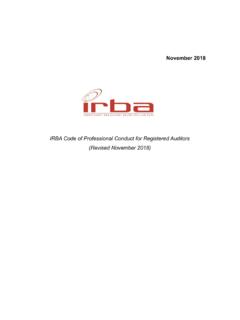Transcription of Pathways to Resettlement - GOV.UK
1 Pathways to Resettlement Youth Offending Service case managers should consider the seven Resettlement Pathways detailed below as part of all intervention planning, alongside any additional individual needs of the young person. Understanding the Pathways 1) Case management and Transitions The main objective of this pathway is to ensure that young people serving custodial sentences receive effective, end-to end service provision based on a thorough assessment of need and risk, in order to reintegrate them into the community. To do this, the following need to be in place: 1. case management which supports continuous service delivery throughout the Resettlement process 2. delivery of appropriate interventions based on the individual need, risk of self-harm and harm to others of each young person 3. partnership working and the timely exchange of relevant information 4. participation of young people and their families or carers in the Resettlement process.
2 Good case management combines: thorough multi-agency assessment of the risk factors associated with offending and the individual needs of each young person One plan tailored to address the identified risks and needs of each young person, focused from the outset on promoting a sustainable and safe return to the community continuity of oversight and support from the YOT co-ordination of the contributions of the different agencies, ensuring that services are sustained beyond the period served in custody and beyond the end of the licence timely exchange of information Young people serving custodial sentences go through the following transitions: community to custody custody back to the community community to mainstream services and for some, from youth to adult services Each transition results in disruption to routine, relationships, activities and flow of information and therefore needs to be managed. Good case management can provide continuity during these transitions and improve opportunities to engage young people in services and activities within their own community.
3 2) Accommodation In order to achieve effective Resettlement , partners need to ensure the young person has safe, suitable, and sustainable accommodation secured ahead of their release from custody. The main objective of this pathway is to ensure that all young people leaving custody can access suitable and sustainable accommodation with support where appropriate. This is done by: 1. assessing the housing needs of young people in custody, and contributing to research evidence and data to inform future housing provision 2. increasing the provision of suitable and sustainable accommodation for 16 to 17-year-olds leaving custody 3. ensuring immediate access to suitable accommodation for 16 to 17-year-olds on release from custody 4. ensuring young people leaving custody receive the appropriate level of housing support to sustain suitable accommodation, once back in the community 5. developing interventions to support young people and their families to sustain relationships and facilitate their return to the family home, where appropriate.
4 The National Standards for Youth Justice Services states that the Youth Offending Service case manager must: assess accommodation needs prior to transfer to the community, ensuring that satisfactory accommodation is available prior to release, and inform the Youth Offending Service manager if this is not provided . It is recommended that a protocol is developed between the Youth Offending Service, local Children s Services and the Local Authority Housing Department in relation to accommodating young people leaving custody. 3) Education, Training and Employment (ETE) The main objective of this pathway is to provide all young people with suitable and sustainable Education, Training and Employment throughout their sentence and beyond, and supporting 16 and 17 year olds to meet their duty to participate. This is done by: 1. ensuring continuity of Education, Training and Employment provision (including personal and social skills) through all the stages of transition community to custody, custody to community, between secure establishments, and beyond sentence 2.
5 Improving engagement into mainstream Education, Training and Employment on release from custody 3. ensuring that young people released from custody know where to go for support in the area that they will live in on release, and that they are aware of the financial support that may be available to help them to continue in education. 4. Youth Offending Services, Secure Establishments and Local Authority Children and Young People s services working together to ensure that the young person has an integrated package of support and that the services involved are clear about their roles and responsibilities 5. use of Temporary Release to enhance Education, Training and Employment opportunities whilst within the secure estate to enhance preparation for release The National Standards for Youth Justice Services states that once a custodial placement is made the Youth Offending Service must notify any relevant authorities within the home and host children s services and education departments as soon as is practical following the placement being made and that secure estate staff must: update assessment information prior to the initial planning meeting.
6 This assessment must incorporate: a full education assessment, including, but not limited to, literacy and numeracy levels and learning difficulties . Education provided during custody should be in line with Resettlement planning and available education, training and employment in the community. The Youth Offending Service should also ensure that the Local Authority Children and Young People s service in the area where the young person is being accommodated is told of their release and that relevant information is shared with the local authority. For those young people that may not be ready to return to education, employment or training immediately on release, engagement programmes to support young people back into learning should be considered. Raising the Participation Age The government has raised the participation age (RPA1) so that all young people in England are now required to continue in education or training for longer. Pupils who reached the statutory school leaving age in summer 2013 have to continue in education or training for at least a further year until June 2014.
7 Pupils who reach the statutory school leaving age from summer 2014 need to continue until at least their 18th birthday. This applies to young people leaving custody and is a crucial element of effective Resettlement . Young people have a choice about how they meet the duty. This could be through: full-time study in a school, college or with a training provider; full-time work or volunteering (20 hours or more) combined with part-time education or training; or an apprenticeship or traineeship Financial assistance for 16 to 19 year olds Bursary funds may be available to support young people from vulnerable groups to overcome financial barriers to participation. Youth Offending Services can find out more information on this support from their Local Authority and on - 4) Health The main objective of this pathway is to ensure that all young people in custody have timely access to suitable and sustainable general and specialist healthcare services, based on individual need, so that problems are identified, assessed and treated at the earliest opportunity and in the most appropriate manner.
8 The following form the basis of this aim: 1. appropriate assessment of health needs 2. access to, and continuity of, appropriate health care services in custody and the community 1 Further information about RPA and what it means for young people can be found here: 3. sharing with relevant services information concerning the young person s treatment, on a need-to-know basis, and with the young person s informed consent 4. improving the health and well-being of young people in custody, and providing them with information to make healthy choices. The National Standards for Youth Justice Services states that secure estate staff must ensure completion of the Comprehensive Health Assessment Tool, an assessment of mental health needs as well as an assessment for substance abuse is undertaken as soon as possible on arrival in custody and where instances of self-harm or suicide attempts occur, [secure estate staff must] ensure that healthcare is provided in accordance with section of NICE clinical guideline 16 (self-harm).
9 5) Substance Misuse The main objective is to ensure all young people entering custody are screened for substance misuse to identify need, with recognition of previous interventions. Those with identified needs should receive specialist substance misuse assessment and timely access to the appropriate intervention and treatment services, with their aftercare needs met on return to the community. This involves: 1. ensuring delivery of substance misuse interventions that are age- appropriate, based on effective practice and evidence-based both within the secure estate and in the community 2. working to minimise the risk of substance misuse, including overdose, by the young person during custody and on release 3. ensuring that relevant information concerning treatment of a young person is effectively shared, with their informed consent, with relevant services throughout the sentence and Resettlement process. The National Standards for Youth Justice Services states that where withdrawal treatment is needed, the young person must be referred to a specialist doctor or nurse and a drug or alcohol worker, who may be based in the secure establishment or the community and that secure estate staff must update assessment information prior to the initial planning meeting.
10 This assessment must incorporate: a full substance misuse assessment in line with the Public Health England publication 6) Families The main objective of this pathway is to ensure that families of young people in custody receive timely, high-quality support and information, from the point of arrest and throughout the young person s sentence. This involves: 1. enabling families to have better access to quality contact with young people in custody 2. providing interventions and support for young people and their families to enable them to maintain strong and supportive relationships 3. providing support and training for young people in custody who are parents The National Standards for Youth Justice Services states the Youth Offending Service must maintain a level of contact with the young person and their parents/carers consistent with supporting them through the custodial part of their sentence and in order to plan properly for their Resettlement back into the community.














